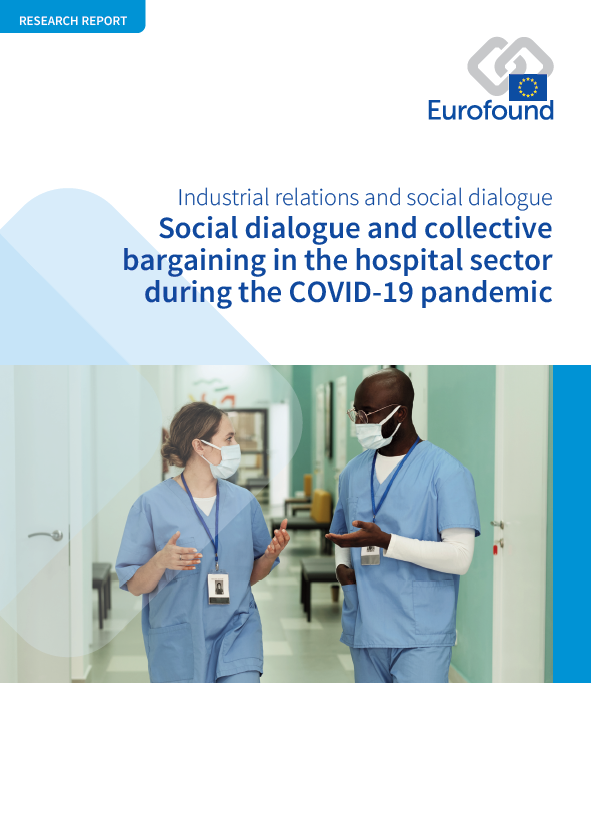
This report analyses the role of social dialogue and collective bargaining in addressing the challenges created or exacerbated by the COVID-19 pandemic in the hospital sector. It also explores whether existing social dialogue and collective bargaining processes at national level were adapted in order to address these new challenges. The research included a literature review to contextualise the structural features of the hospital sector and an analysis of policy initiatives to manage the crisis implemented across the EU27 and Norway. The findings indicate that the level and nature of the social partners’ involvement in pandemic responses varied across Europe. Social dialogue and collective bargaining played a prominent role in some countries, while in others the social partners were less involved. Although no substantial changes were identified in social dialogue institutions and processes, the breadth of issues they deal with expanded beyond the traditional areas of employment and working conditions.
Key findings
In countries with a long-standing tradition of cooperation between the social partners, social dialogue and collective bargaining played a prominent role in addressing some of the challenges posed by the COVID-19 pandemic to the hospital sector. Negotiations between the social partners were crucial for, among other issues, agreeing the changes to work organisation required to tackle the health crisis and the successful allocation of additional funding and resources.
During the COVID-19 crisis, social dialogue and collective bargaining were essential in finding solutions to the challenges in the hospital sector in some countries where they usually do not play a prominent role. Bulgaria, Cyprus, Czechia, Estonia and Malta, for example, saw a boost in social dialogue in the hospital sector. Conversely, in the countries most affected by austerity measures in the health sector following the 2007–2008 financial crisis – namely Greece, Portugal and Spain – and whose healthcare systems had not fully recovered from the staff cuts and pay freezes of that period, governments implemented legislation without the involvement of the social partners, who played a limited role in managing the overall response.
The pandemic saw the social partners in the hospital sector engaging in topics beyond the traditional issues of pay and working time. The need to secure workforce capacity in hospitals often required their involvement in the adaptation of work organisation practices and the reallocation of staff and in other measures related to the protection of staff health and safety.
The pandemic exacerbated existing staff shortages and is likely to lead to greater international competition for the recruitment of health workers. The social partners in this sector are increasingly concerned about the impact that high levels of stress and workload may have on staff retention, as these are factors often associated with workers’ intentions to leave the sector.
The findings reveal that where social dialogue and collective bargaining played a prominent role in addressing the challenges faced by the hospital sector during the COVID-19 pandemic, the responses were better and more quickly developed. This highlights how well-functioning social dialogue and collective bargaining are crucial to a strong hospital sector and can increase the EU’s preparedness for potential future health crises.
The report contains the following lists of tables and figures.
List of tables
- Table 1: Distribution of social dialogue and collective bargaining practices, by type of social partner involvement and issues covered
- Table 2: Bargaining level of pay initiatives addressed in social dialogue and collective bargaining rounds
- Table 3: Summary of major developments in social dialogue and collective bargaining in the hospital sector during the COVID-19 pandemic in different industrial democracy clusters
List of figures
- Figure 1: Change in employment in the hospital sector (%), EU Member States, 2015–2020
- Figure 2: Share of hospital employment out of total employment (%), EU Member States and the United Kingdom, 2015 and 2020
- Figure 3: Breakdown of hospital doctors by gender (%), EU Member States and Norway, 2019
- Figure 4: Breakdown of hospital doctors by age (%), EU Member States and Norway, 2019
- Figure 5: Ratio of nurses and midwives to doctors in hospitals (full-time equivalents), EU Member States, Norway and the United Kingdom, 2019 or most recent data available
- Figure 6: Share of temporary employment in hospital sector and total employment (%), EU Member States, 2020
- Figure 7: Share of part-time employment in hospital sector and total employment (%), EU Member States, 2020
- Figure 8: Share of foreign-trained doctors in country (%), EU Member States, Norway and the United Kingdom, 2019
- Figure 9: Share of foreign-trained nurses in country (%), EU Member States, Norway and the United Kingdom, 2019
- Figure 10: Distribution of hospital beds (%), by type of ownership, EU Member States, 2019
- Figure 11: Remuneration of nurses and doctors (salary ratio to national average wage), EU Member States, Norway and the United Kingdom, 2019
- Figure 12: Wages of hospital nurses and specialists in selected central and eastern European countries, 2010–2019
- Figure 13: Wages of hospital nurses and specialists in Greece, Ireland, Italy, Portugal and Spain, 2010–2019
- Number of pages
-
52
- Reference nº
-
EF21030
- ISBN
-
978-92-897-2296-4
- Catalogue nº
-
TJ-05-22-381-EN-N
- DOI
-
10.2806/660968
- Permalink
Cite this publication
Eurofound (2022), Social dialogue and collective bargaining in the hospital sector during the COVID-19 pandemic, Publications Office of the European Union, Luxembourg.
